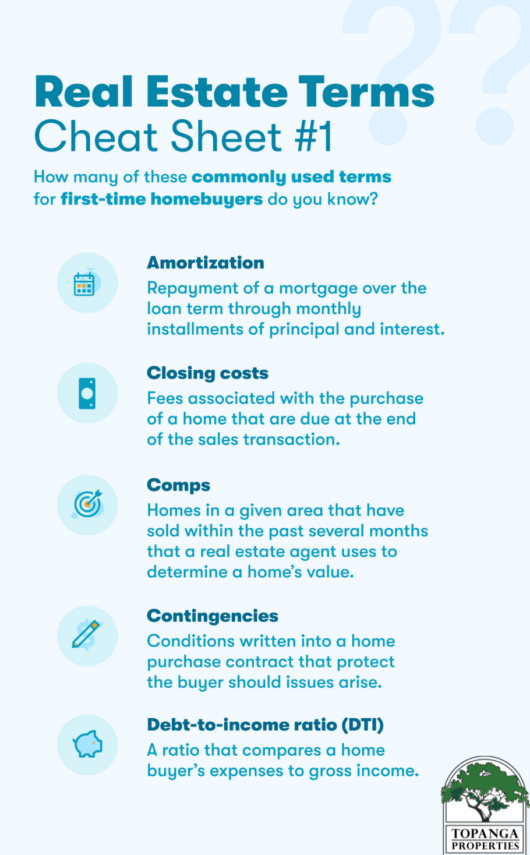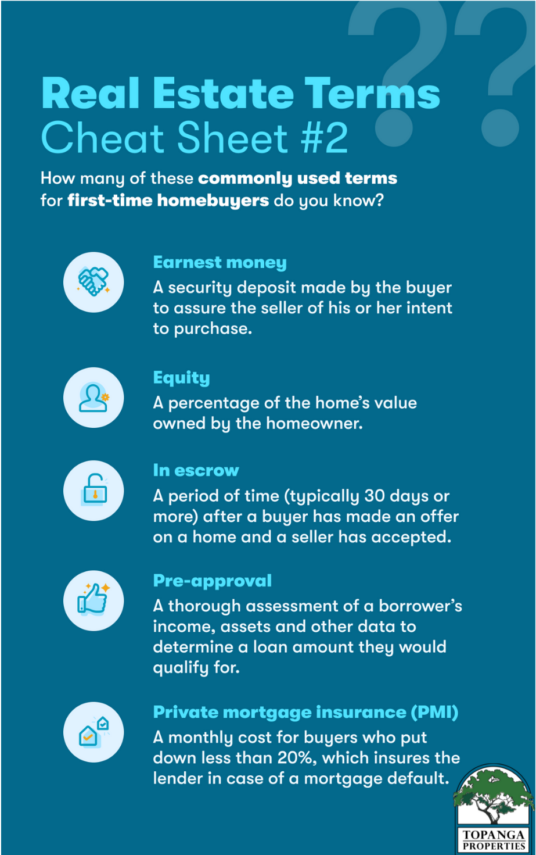Whether you’re ready to buy your first home or just need an acronym refresher, keep this glossary handy.

You don’t need a real estate license to find your dream home, but it does help to become familiar with real estate jargon you might encounter during the process. When searching for a home or applying for a mortgage, you may hear your real estate agent or lender use any of the terms or acronyms below.
Keep this five-part guide handy — you’ll be fluent in the language of home buying before you know it.
Real estate terms to know when you’ve started house hunting
1. Affordability
Affordability or home affordability refers to the amount of money you can comfortably afford to spend on a home. Home affordability takes into account your income, down payment, and monthly debts. Try our affordability calculator to see how much house you might be able to afford.
2. Buy-rent breakeven horizon
A concrete point at which buying a home makes more financial sense than renting one. Read more about the Buy-Rent Breakeven Horizon here.
3. Buyers market
Market conditions that exist when homes for sale outnumber buyers. Homes can sit on the market for a long time, and prices tend to drop.
4. Comparative market analysis (CMA)
An in-depth analysis, prepared by a real estate agent, that determines the estimated value of a home based on recently sold homes of similar condition, size, features and age that are located in the same area.
5. Comps
Or comparable sales, are homes in a given area that have sold within the past several months that a real estate agent uses to determine a home’s value.
6. Days on market (DOM)
The number of days a property listing is considered active.
7. Listing price
The price of a home, as set by the seller.
8. Multiple listing service (MLS)
A database where real estate agents list properties for sale.
9. Sellers market
Market conditions that exist when buyers outnumber homes for sale. Bidding wars are common. Prices are often higher than average.
10. Short sale
The sale of a home by an owner who owes more on the home than it’s worth. The owner’s bank must approve a lower listing price before the home can be sold. Learn more about short sales here.

Learn these definitions before you start shopping for a mortgage
11. Conventional loan
A home loan not guaranteed by a government agency, such as the FHA or the VA. Read more about conventional loans here.
12. Down payment
A certain portion of the home’s purchase price that a buyer must pay. A minimum requirement is often dictated by the loan type. Learn more about down payments here.
13. Fannie Mae®
A government-sponsored enterprise chartered in 1938 to help ensure a reliable and affordable supply of mortgage funds throughout the country.
14. Federal Housing Administration (FHA)
A government agency created by the National Housing Act of 1934 that insures loans made by private lenders. The Federal Housing Administration is part of the U.S. Department of Housing and Urban Development.
15. FHA 203(k)
A rehabilitation loan backed by the federal government that permits home buyers to finance money into a mortgage to repair, improve or upgrade a home.
16. FHA loan
Loans from private lenders that are regulated and insured by the Federal Housing Administration (FHA). FHA loans are different from conventional loans because they can be approved for borrowers with lower credit scores and may allow for down payments as low as 3.5 percent of the total loan amount. Maximum loan amounts can vary by county. Read more about FHA loans here.
17. Fixed-Rate Mortgage
A mortgage with principal and interest payments that remain the same throughout the life of the loan because the interest rate does not change.
18. Foreclosure
A property repossessed by a bank when the owner fails to make mortgage payments. Learn more about foreclosure here.
19. Freddie Mac®
A government agency chartered by Congress in 1970 to provide a constant source of mortgage funding for the nation’s housing markets.
20. Mortgage Banker
One who originates, sells, and services mortgage loans and resells them to secondary mortgage lenders such as Fannie Mae or Freddie Mac.
21. Mortgage broker
A licensed professional who works on behalf of the buyer to secure financing through a bank or other lending institution.
22. Private Mortgage Insurance
Private Mortgage Insurance or PMI, is a monthly mortgage insurance premium paid by a borrower for a mortgage insurance policy. Mortgage insurance protects the lender if the borrower defaults on the mortgage loan. Mortgage insurance is usually required on a conventional mortgage loan and the down payment is less than 20 percent of the sale price. Read more about mortgage insurance.
23. Mortgage interest rate
The price of borrowing money. The base rate is set by the Federal Reserve and then customized per borrower, based on credit score, down payment, property type and points the buyer pays to lower the rate.
24. Piggyback loan
A combination of loans bundled to avoid private mortgage insurance. One loan covers 80% of the home’s value, another loan covers 10% to 15% of the home’s value, and the buyer contributes the remainder.
25. Prepayment penalty
A prepayment penalty is a fee some lenders may charge if you pay off some or all of your mortgage early. Not all mortgages carry a prepayment penalty. Be sure to read the fine print carefully.
26. Prime rate
Prime rate is the interest rate charged by a lender to customers who are the least likely to default on their loans. The most credit-worthy customers (mainly large corporations), receive the best or lowest rate that the lender would offer any of its customers. Each lending institution sets its own prime rate. Typically, most consumers’ mortgage interest rate is going to be higher than the prime rate.
27. Principal, interest, property taxes and homeowners insurance (PITI)
The components of a monthly mortgage payment.
28. Private mortgage insurance (PMI)
A fee charged to borrowers who make a down payment that is less than 20% of the home’s value. The fee, 0.3% to 1.5% of the yearly loan amount, can be canceled in certain circumstances when the borrower reaches 20% equity. Read more about PMI here.
29. Points
Prepaid interest owed at closing, with one point representing 1% of the loan. Paying points, which are tax deductible, will lower the monthly mortgage payment.
Study these real estate terms when you’re applying for a mortgage
30. Adjustable-rate mortgage (ARM)
An adjustable-rate mortgage, or ARM, has an introductory interest rate that lasts a set period of time and adjusts every six months thereafter for the remaining loan term. After the set time period your interest rate will change and so will your monthly payment. Learn more about adjustable-rate mortgages here.
31. Back-end ratio
One of two debt-to-income ratios that a lender analyzes to determine a borrower’s eligibility for a home loan. The ratio compares the borrower’s monthly debt payments to gross income. Read more about back-end ratio here.
32. Closing disclosure
This is a statement a borrower will receive from their lender at least three days before closing on a home. The line items should look similar to what a borrower sees on their loan estimate when first applying — there are limits to how much any fees can change in the time period between application and closing day, so borrowers should review their closing disclosure closely and ask their lender about any changes.
33. Depository institutions
Banks, savings and loans, and credit unions. These institutions underwrite as well as set home loan pricing in-house.
34. Debt-to-income ratio (DTI)
A ratio that compares a home buyer’s expenses to gross income. Try our debt-to-income calculator to learn more.
35. Housing ratio
One of two debt-to-income ratios that a lender analyzes to determine a borrower’s eligibility for a home loan. The ratio compares total housing cost (principal, homeowners insurance, taxes and private mortgage insurance) to gross income.

36. Loan estimate
A three-page document sent to an applicant three days after they apply for a home loan. The document includes loan terms, monthly payment and closing costs. A loan estimate can help borrowers shop and compare costs of loans with lenders. You are not obligated to accept the loan just because you received a loan estimate. Smart mortgage shoppers apply for at least two loans and use the loan estimates to determine which lender they want to use.
37. Loan-to-value ratio (LTV)
The amount of the loan divided by the price of the house. Lenders reward lower LTV ratios.
38. Origination fee
A fee, charged by a broker or lender, to underwrite and process a home loan application. An origination fee is not a single fee. It’s a set of lender-specific fees that are part of your costs when closing a mortgage loan. Read more about origination fees here.
39. Pre-approval
A thorough assessment of a borrower’s income, assets and other data to determine a loan amount they would qualify for. A real estate agent will request a pre-approval or pre-qualification letter before showing a buyer a home. Learn more about pre-approval here.
40. Pre-qualification
A basic assessment of income, assets and credit score to determine what, if any, loan programs a borrower might qualify for. A real estate agent will request a pre-approval or pre-qualification letter before showing a buyer a home. Read more about pre-qualification here.
41. Underwriting
A process a lender follows to assess a home loan applicant’s income, assets and credit, and the risk involved in offering the applicant a mortgage.
Real estate terms you might hear when you’ve had your offer accepted
42. American Society of Home Inspectors (ASHI)
A not-for-profit professional association that sets and promotes standards for property inspections. Look for this accreditation or something similar when shopping for a home inspector.
43. Cash-value policy
A homeowners insurance policy that pays the replacement cost of a home, minus depreciation, should damage occur.
44. Closing costs
Fees associated with the purchase of a home that are due at the end of the sales transaction. Fees may include the appraisal, the home inspection, a title search, a pest inspection and more. Buyers should budget for an amount that is 2% to 5% of the home’s purchase price. Read more about closing costs here.
45. Contingencies
Conditions written into a home purchase contract that protect the buyer should issues arise with financing, the home inspection, etc.
46. Earnest money
A security deposit made by the buyer to assure the seller of his or her intent to purchase.
47. Escalation clause
A clause or addendum to a real estate contract or offer that states a buyer is willing to raise his or her offer price to a predetermined amount if the seller receives a higher competing offer for the property. Read more about escalation clauses and making an offer on a home.
48. Mortgage escrow account
An account required by a lender and funded by a buyer’s mortgage payment to pay the buyer’s homeowners insurance and property taxes. A portion of your monthly payment goes into the escrow account to cover taxes and insurance. If your mortgage doesn’t have an escrow account, you may pay the property-related expenses directly.

49. Escrow state
A state in which an escrow agent is responsible for closing.
50. Home inspection
A visual evaluation performed by a licensed home inspector to look for any potential defects or items of note related to the property, building(s), and the systems in a home. Inspection occurs when the home is under contract or in escrow.
51. Homeowners insurance
A policy that protects the structure of the home, its contents, injury to others and living expenses should damage occur. Learn more about homeowners insurance here.
52. In escrow
A period of time (typically 30 days or more) after a buyer has made an offer on a home and a seller has accepted. During this time, the home is inspected and appraised, and the title searched for liens, etc.
53. Title insurance
Insurance that protects the buyer and lender should an individual or entity step forward with a claim that was attached to the property before the seller transferred legal ownership of the property or “title” to the buyer.
54. Transfer taxes
Fees imposed by the state, county or municipality on transfer of title.
55. Under contract
A period of time (typically 30 days or more) after a buyer has made an offer on a home and a seller has accepted. During this time, the home is inspected and appraised, and the title is searched for liens, etc.
56. Walkthrough
A buyer’s final inspection of a home before closing.
Words to know when you own a home
57. Amortization
Repayment of a mortgage over the loan term through regular monthly installments of principal and interest, based on an amortization schedule. If you have made your required monthly payments, at the end of the loan term (e.g., 15 or 30 year mortgage), you will own your home. Try our amortization calculator to learn more.
58. Deed
A deed is the legal document that establishes ownership of real property, and is also used to transfer the ownership of real property to another person or entity.
59. Equity
A percentage of the home’s value owned by the homeowner.
60. Homeowners association (HOA)
The governing body of a housing development, condo or townhome complex that sets rules and regulations. They charge dues used to maintain common areas. Learn more about HOAs here.
61. Lien
A lien is any legal claim upon a property for a debt or a non-monetary interest in the property. A lien is a security interest that can give a creditor the right to take possession of a property secured by a loan, such as a mortgage, when the borrower defaults on the loan obligations. Most lenders will require title insurance to protect their interests should there be outstanding liens on the property securing their security interest.
62. Property tax exemption
A reduction in taxes based on specific criteria, such as installation of a renewable energy system or rehabilitation of a historic home.
63. Refinancing
The act of paying off one loan by obtaining another. Refinancing is generally done to secure better loan terms, such as a lower interest rate. Learn more about refinancing here.
64. Tax lien
The government’s legal claim against property when the homeowner neglects or fails to pay a tax debt.


Leave a Reply